Understanding Kiteboarding Seat Harnesses for Performance
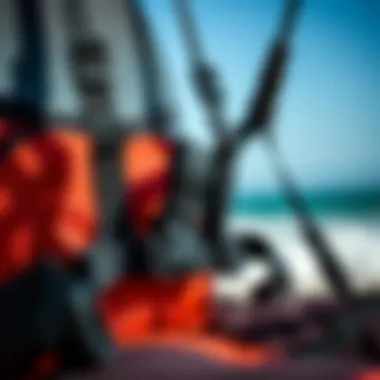
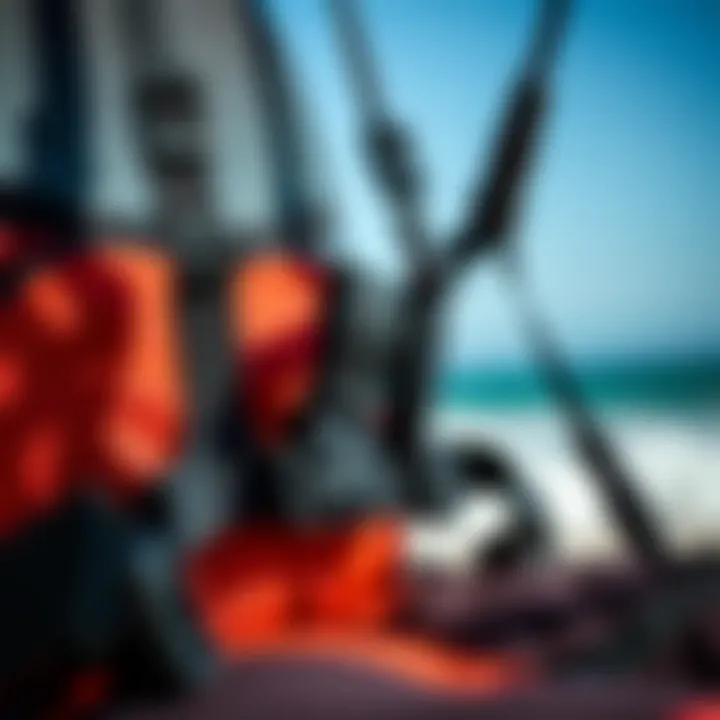
Intro
Kiteboarding is not just about the thrill of riding the waves; it’s a complex sport that combines various elements of skill, equipment, and safety. One of the most crucial pieces of gear in this dynamic sport is the seat harness. Understanding how these harnesses work can dramatically affect one's comfort and performance on the water. This guide will delve into the essence of kiteboarding seat harnesses, unveiling their types, features, and maintenance while spotlighting the impact of a proper fit on your safety.
As we explore this important aspect of kiteboarding, we’ll break down essential gear for beginners, carry on to advanced equipment for seasoned riders, and provide insights into techniques that can enhance your kiteboarding experience. The aim is clear: equip both novice and experienced kiteboarders with a solid grasp of harnesses, helping you glide through the waves with ease and confidence.
Prelude to Kiteboarding Seat Harnesses
Kiteboarding is an exhilarating sport that combines elements of surfing, wakeboarding, and flying a kite. Central to this activity is the kiteboarding seat harness, an often overlooked yet essential piece of equipment that influences both performance and enjoyment on the water.
The kiteboarding seat harness wraps around the torso, connecting the rider to the kite via the lines. Its importance cannot be overstated; it provides support, comfort, and effective power transfer from the kite to the board. Without a well-fitting harness, kiteboarders can experience discomfort, struggle to control their movements, or even risk injury. The right harness not only enhances one's experience but can also significantly improve riding technique.
In this guide, we'll dive deep into the world of seat harnesses, shedding light on their various types, key features, and how to select the right one tailored to your needs. We aim to provide both beginners and seasoned riders with a comprehensive understanding of this vital gear, ensuring that every adventure on the water is safe and enjoyable.
Types of Kiteboarding Seat Harnesses
When it comes to kiteboarding, the seat harness is more than just a piece of gear; it’s a crucial element that can greatly influence your overall ride experience. Understanding the different types of kiteboarding seat harnesses can help you make informed decisions as you seek comfort and performance on the water. The right harness brings not only security but also a sense of connection with the kite, enabling you to harness its power more effectively.
As we explore the options available, we'll delve into crucial factors such as design, functionality, and user preferences, ensuring that every kiteboarder, regardless of skill level, can find their ideal match.
Traditional Seat Harness
The traditional seat harness is often the go-to choice for those just starting out or for riders who prefer a bit of simplicity in their gear. Often characterized by a wider, low-profile design, this type of harness sits lower on the waist and provides ample support through the thighs. One of the prominent benefits is its ability to distribute pressure evenly, which is essential for long hours spent on the water.
Due to its straightforward design, these harnesses are typically more affordable. They’re built to last, often using durable materials like nylon with a reinforced stitching approach that can withstand the wear and tear of kiteboarding.
- Pros:
- Cons:
- Budget-friendly options
- Excellent for beginners
- Even pressure distribution
- May lack some advanced features
- Less mobility compared to others
Whether you’re navigating through calm waters or breaking the waves, a traditional seat harness provides enough support and simplicity for those testing their limits.
Adjustable Seat Harness
Next on the list is the adjustable seat harness, a favorite for many intermediate riders and those who want a customizable fit. This type often features multiple adjustment points, allowing for tailored snugness around the waist and thighs. As your skill level progresses, you want your gear to adapt just as much as you do.
Flexibility in design is a vital point here. With adjustable straps, riders can tweak their harness for comfort as conditions change or as their riding style evolves. This harness can often come with padding options, enhancing comfort during harder riding sessions and granting the rider improved movement without sacrificing support.
- Pros:
- Cons:
- Customizable fit for various body types
- Better comfort for extended use
- Versatile for different riding styles
- Can be more expensive than traditional harnesses
- Design might complicate re-adjustments during sessions
In its adjustable nature, this harness opens the door for flexibility, keeping you secure while letting you finesse your skills.
High-Performance Seat Harness
The high-performance seat harness is engineered for the experienced kiteboarder who craves the optimal fusion of freedom, support, and advanced features. Typically employing lightweight materials and ergonomic designs, these harnesses enhance mobility without sacrificing durability. Many of these harnesses incorporate advanced technologies such as internal frames or even integrated flotation devices, aiming to support the rider through more dangerous maneuvers.
One key aspect of high-performance harnesses is their ability to keep the rider connected to the kite while drastically reducing the chances of fatigue during aggressive riding sessions. These harnesses often feature sleek profiles that cut down on bulk, making transitions smoother and tricks easier to execute.
- Pros:
- Cons:
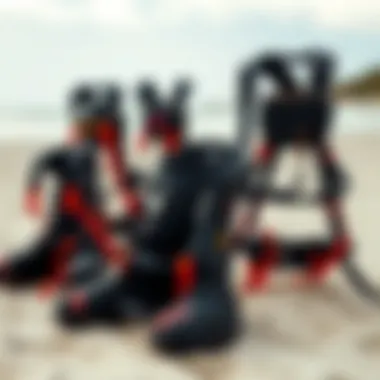
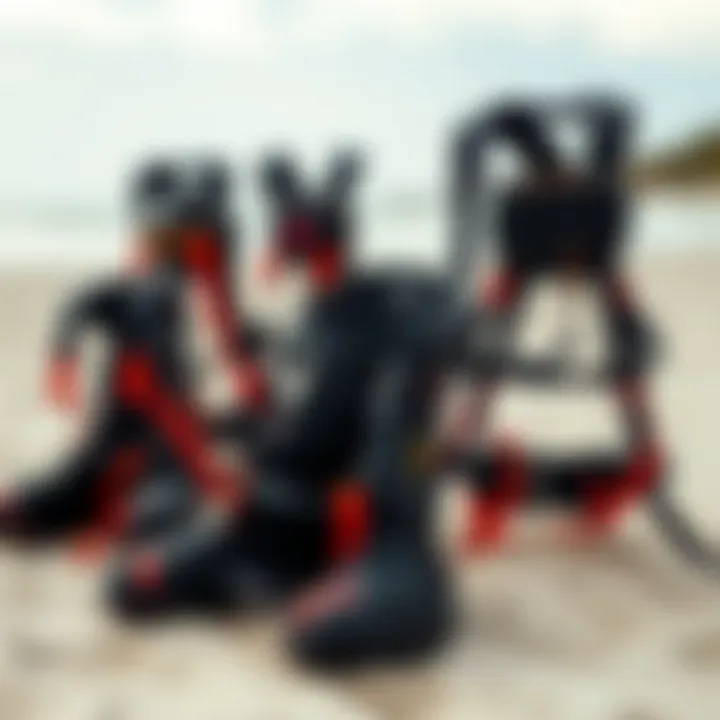
- Enhanced responsiveness and flexibility
- Built for aggressive riding styles
- Incorporates cutting-edge materials and technologies
- Higher price point
- May be overkill for beginners
If you’re a seasoned rider operating at the top of your game, this harness will meet your performance demands and keep you riding efficiently.
In summary, the different types of kiteboarding seat harnesses cater to various needs, from affordability and comfort to performance-driven designs. Picking the right harness often hinges upon personal preferences, riding style, and skill level, but understanding these distinct varieties can guide you to make a choice that enhances both your performance and enjoyment on the water.
Choosing the Right Seat Harness
Choosing the right seat harness is a pivotal decision for anyone venturing into the kiteboarding world. This choice goes beyond mere comfort; it can significantly impact your performance, safety, and overall experience on the water. An ill-fitting harness can lead to discomfort and fatigue, distracting you from the sheer joy of riding the waves. On the flip side, the right harness will feel like a part of you, allowing your body to work in harmony with your kite.
Sizing and Fit Considerations
When selecting a seat harness, sizing and fit are paramount. A harness that is too loose may shift during movement, causing unwanted strain. Conversely, one that is overly tight can restrict circulation and lead to numbness, a scenario no rider wants to experience.
To ensure you find the right fit, consider the following steps:
- Measure Your Waist: Use a soft measuring tape to get your waist size. Ensure it's snug yet comfortable around your body.
- Try It On: If possible, try on the harness before purchasing. Move around, mimic riding positions, and see how it feels.
- Check the Adjustability: Look for harnesses with adjustable straps or features to accommodate changes in clothing or body shape.
A good rule of thumb: your harness should feel snug without causing discomfort or pinching. If you're experienced, you may prefer a tighter fit for enhanced control. But, for beginners, comfort should take precedence as you get used to new sensations.
Material Choices and Durability
The material of a seat harness plays a sliding-scale role in both durability and comfort. Common materials include neoprene, nylon, or a blend designed specifically for the rigors of kiteboarding. Here's what to consider:
- Neoprene: While it offers stretch and comfort, it may not be as durable as other materials. However, it’s often favored for its water resistance.
- Nylon: A staple in harness construction, nylon is robust and can withstand significant wear and tear. This is crucial for those who kiteboard frequently.
- Reinforced Stitching: Look for harnesses with reinforced seams; they offer additional durability.
In short, when looking for materials, think about your style of riding and how often you’ll be hitting the water. A rugged, well-made harness can last you through many seasons if properly cared for.
Functionality and Features to Look For
Evaluating the features of a seat harness is like reading a map before a journey. You want to ensure that you'll have the tools you need at your disposal. Here are essential functionalities to look for:
- Adjustable Straps: These allow you to customize the fit for comfort and control.
- Quick-Release Mechanism: Safety features like a quick-release are crucial for emergencies. Make sure the mechanism is intuitive to use.
- Pockets or Attachments: Some harnesses come with pockets for securing essentials or attachment points for accessories.
- Padding: Adequate padding can enhance comfort and lessen the risk of chafing, especially during longer sessions.
In essence, selecting the right seat harness is not merely about fashion or brand—it's about enhancing your performance and experience on the water. A thoughtful approach ensures you pick a harness that meets your specific needs and gives you the confidence to ride harder, longer, and smarter.
A well-chosen harness not only aligns with your body but also with your kiteboarding journey, improving each ride you take.
For more in-depth information, check out resources like Kiteboarding Wiki and community forums on Reddit.
How to Properly Use a Kiteboarding Seat Harness
The effectiveness of a kiteboarding seat harness isn't solely in its design. It significantly hinges on how you engage with it on the water. Proper usage directly influences your comfort, performance, and safety while kiteboarding. A well-adjusted harness enables you to harness the kite's pull effectively, allowing you to maneuver with ease. In this section, we'll dissect the crucial aspects of adjusting and utilizing your harness, ensuring that you maximize every ride.
Adjusting the Harness for Comfort
Fitting your kiteboarding seat harness correctly is paramount. An ill-fitting harness can cause discomfort, hindering your performance and even posing safety risks. To achieve a comfortable fit, one must consider a few factors:
- Tightness: When you strap on the harness, it should hug your waist snugly without being overly restrictive. Pressing the harness should feel secure yet allow you to breathe freely.
- Positioning: The harness should sit low on your hips, as this distributes the load evenly across your body. The strap should anchor just above your thighs.
- Adjustments: Most seat harnesses have adjustable straps on the sides or back. Take time to tweak these until you find that sweet spot. If it takes a couple of tries, don't worry; this process can greatly enhance your experience.
The goal here is to avoid the dreaded pinching or chafing that can come from an improper fit. Don't hesitate to fiddle with the adjustments at the beach before heading out, so you hit the water feeling at ease.
Techniques for Using the Harness Effectively
Once you have adjusted your seat harness, understanding how to maximize its benefits is crucial. Here are some techniques you might find helpful:
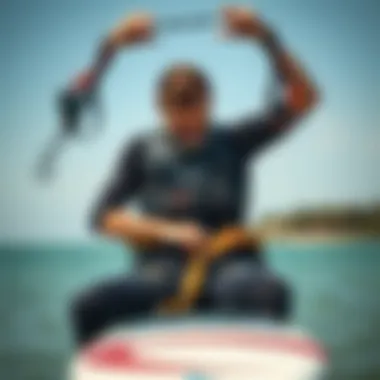
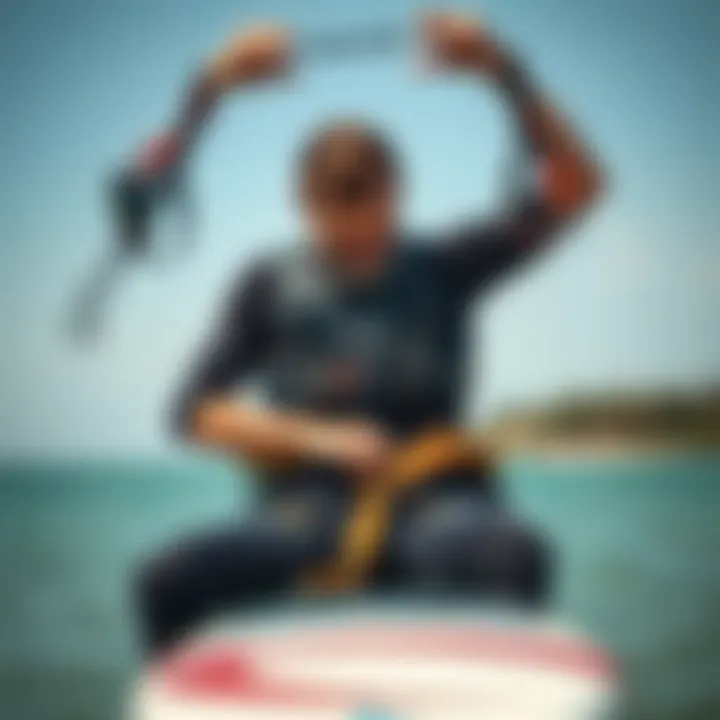
- Posture: Keep a slight bend in your knees and maintain an upright posture. This positioning not only engages your core but also allows for better control of your movements.
- Weight Distribution: Lean back slightly against the harness to utilize its support. Shifting your weight properly can make balancing on the board feel second nature.
- Pulling the Kite: Use the harness to support your arms when steering the kite. Instead of solely relying on upper body strength, let the harness do the work, which can save you more energy for those longer rides.
"A properly used harness transfers the power effectively – leave the muscle to the kite, not you."
Remember that kiteboarding demands a skillful synergy between the harness and your technique. Practice integrating these tips into your sessions, and you'll likely notice improvements in your overall experience and performance out on the water.
Maintenance and Care for Seat Harnesses
Taking care of your kiteboarding seat harness is as crucial as picking the right one in the first place. Without proper maintenance, even the best harness can become a liability rather than an asset. Regular care not only prolongs the lifespan but also ensures that your harness performs optimally when you hit the water. Whether you're out there on those gusty days or smooth, sunny afternoons, knowing how to maintain your harness can enhance your experience and safety. It’s like tending a garden; neglect it, and you'll be faced with a weeding job you didn’t sign up for.
Cleaning Your Seat Harness
Cleanliness is next to godliness, especially in the world of kiteboarding where salt, sand, and dirt often sneak into every nook and cranny of your equipment. The first step in cleaning your seat harness is to rinse it properly with fresh water after every session. This simple act removes the abrasive salt and grime that can degrade the material over time. Not doing this is akin to leaving a bicycle out in the rain; it’ll rust before you know it.
To tackle deeper dirt, you can use a mild soap solution on a soft cloth or sponge. Gently scrub the harness' straps and buckles, paying extra attention to the areas that experience the most wear. Avoid harsh detergents or any cleaning agents containing bleach; that’s the kiss of death for your gear.
Once you're done scrubbing, rinse thoroughly with water to remove any soap residue. Lay the harness out flat to dry in a shaded area, never direct sunlight as this can warp the materials. Ensuring your harness dries completely prevents mold and odor, keeping it fresh for your next adventure.
Storage Tips for Longevity
Storing your harness correctly is like tucking it in at night; it keeps it safe from harm. Avoid the temptation to just toss it in the corner of your garage or shed. A well-stored harness can last for years.
Here are a few storage tips to keep your harness as good as new:
- Keep it dry: Moisture is a harness’s worst enemy; a damp harness promotes mildew and decay. Always ensure it’s completely dry before storage.
- Cool, dry place: Store the harness in a cool area away from direct sunlight. A temperature-controlled environment is ideal.
- Avoid crushing: Never stack heavy items on top of your harness. This can cause bending and damage that affects the fit and function.
- Use a bag: If possible, store your harness in a dedicated bag to protect it from dust and unintentional tears.
By respecting these simple storage practices, you’ll ensure that your seat harness remains a reliable part of your kiteboarding gear, ready to tackle the waves when you are.
A little maintenance goes a long way; take care of your gear, and it will take care of you when it counts.
Safety Considerations
Kiteboarding is, without a doubt, an exhilarating sport, but it comes with its own set of risks. Understanding safety considerations is imperative for ensuring a secure and enjoyable experience on the water. The seat harness plays a crucial role in this equation. Properly considering aspects of harness selection, fit, and general maintenance not only contributes to performance but also significantly impacts rider safety. This section will delve into the paramount importance of proper fit and recognizing wear and tear in your seat harness.
Importance of Proper Fit for Safety
When it comes to kiteboarding, one size does not fit all, especially regarding seat harnesses. The fit of the harness directly affects both comfort and safety. An ill-fitting harness might not only distract you from fully enjoying the ride but can also pose serious risks. For example, if a harness is too loose, it can shift during use, which could lead to injuries or poor maneuverability. Conversely, a harness that is too tight can restrict movement and circulation, resulting in discomfort and impairing your ability to control the kite effectively.
Some key considerations for ensuring a proper fit include:
- Adjustment Straps: Most seat harnesses come equipped with adjustment straps. Make sure these are correctly used to customize the fit for your body type.
- Leg Loops: The harness should feel snug around your hips and thighs without pinching. You should be able to move freely without excessive pressure on your legs.
- Chest Harness Compatibility: If your style includes a chest harness, consider how both harnesses interact. It's vital that they work seamlessly together without compromising safety.
The right fit enables better control of the kite and enhances your overall riding experience, keeping safety at the forefront of your kiteboarding adventures.
Recognizing Wear and Tear
A seat harness undergoes a lot of stress during its lifetime. Wy've all seen equipment that’s a bit worse for wear, but when it comes to your safety, being proactive about wear and tear can’t be left to chance. Regular inspections of your harness are essential. Look for fraying straps, weakened stitching, or even rust on buckles. These can all signal that it's time to think about repairs or replacements.
Some signs to keep an eye on:
- Frayed Straps: Look for obvious signs of fraying or wear, especially at connection points.
- Stitching Integrity: Check for any loose threads or unraveling seams. This can be a sign the harness is losing its structural integrity.
- Buckles and Adjusters: Ensure all metal parts are free from rust and function smoothly. If they don't, they might fail when you need them most.
If you notice any of these indicators, take action immediately. Ignoring them could lead to dangerous situations on the water, impacting both your safety and enjoyment. Always prioritize quality and regular checks of your equipment.
"A stitch in time saves nine" – applying this saying to your harness can make all the difference in your kiteboarding experience. Prioritizing maintenance and proactively addressing wear can prolong the life of your harness and ensure you stay on the water safely.
Advanced Techniques for Experienced Riders
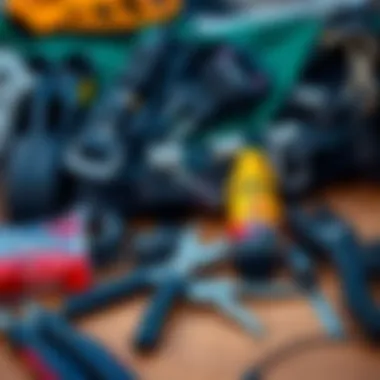
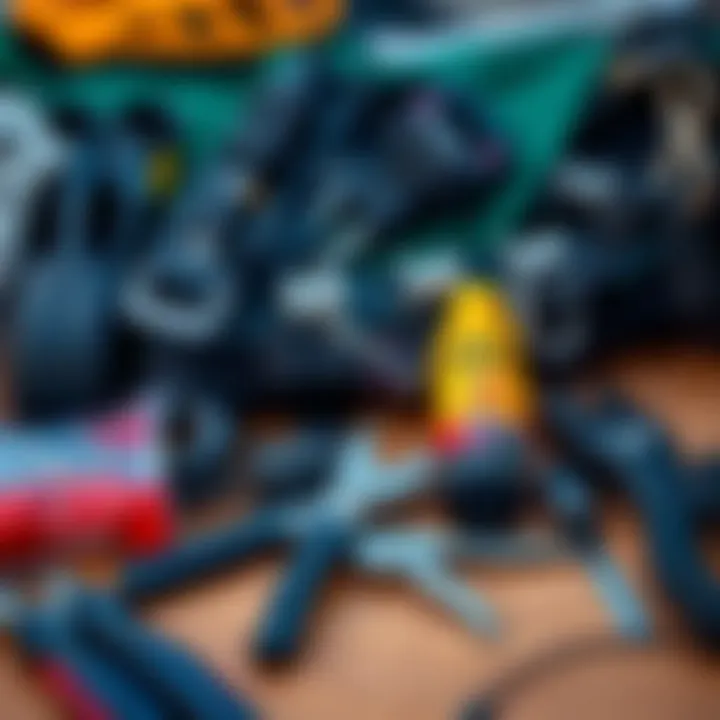
Mastering kiteboarding isn’t just about getting out there and going with the flow; it's about precision. Advanced techniques can elevate the kiteboarding experience, turning a good ride into an exhilarating one. Experienced riders often navigate complex maneuvers that require a deeper understanding of their equipment, including the seat harness. When used correctly, a seat harness can transform kiteboarding into a fluid dance with the wind, allowing for improved control and power management.
Utilizing the Harness for Maneuvering
The way you control your movements on the water can fundamentally change your enjoyment and performance in kiteboarding. The seat harness acts as an anchor point, responding to shifts in weight with impressive agility. Here are a few tips to help you unlock the full potential of your harness for maneuvering:
- Body Positioning: Lean back in your harness to utilize your legs more effectively for steering. Keeping your upper body relaxed will help maintain control, and a proper stance will let your movements translate directly into kite adjustments.
- Trimming the Lines: When making directional changes, adjust the trim of your lines—pulling in or letting out the bar to help the kite respond accordingly. Your harness should work with you as you shift your weight.
- Foot Steering: Engage your feet and legs to help maneuver. If you're initiating a turn, tilt your body weight while pushing away from the kite with your feet, thus giving directional input without unnecessary tension on the lines.
"The key to mastering kiteboarding lies in the rider's ability to blend fluid movements with precise control—where the seat harness plays a pivotal role."
Practicing these techniques can significantly improve your maneuvering skills, allowing for tight turns and quick adjustments in fast-moving conditions.
Harnessing Power with Proper Technique
To harness power effectively in kiteboarding, understanding the dynamics between your kite, harness, and body language is crucial. The focus should be on sustainable performance rather than brute strength. Here’s how to channel that power:
- Use the Harness for Load Management: When the kite catches wind, your torso should be relaxed, allowing the harness to distribute the load across your body. Don’t wrestle with the kite; rather, let the harness support you as you maintain a stable position.
- Angle of Attack: Adjust the angle of your kite in relation to the wind, using the harness to keep you upright and engaged. The optimum angle helps capture power while minimizing drag.
- Sailing on the Edge: By edging upwind, you create a balance between speed and control. Here, the seat harness plays an essential role—your back leg should engage while your front leg acts as a pivot point. This positional awareness lets you make the most of the wind without sacrificing stability or speed.
Integrating these techniques boosts both your performance and your comfort, making long sessions on the water much more enjoyable. Having a good grasp of advanced maneuvers will set you apart from other riders, showcasing not just skill but a deep understanding of kiteboarding dynamics.
Innovations in Kiteboarding Harness Technology
In the ever-evolving world of kiteboarding, the technology behind seat harnesses has not stood still. It’s like watching a magician pull a rabbit out of a hat—each new innovation feels both surprising and necessary. As kiteboarding grows in popularity, the expectations for gear increase too. Today’s harnesses don’t just support; they enhance the entire riding experience. This section explores the latest advancements in materials and technology that redefine how we perceive and utilize kiteboarding harnesses right from the get-go.
Emerging Materials and Designs
Traditionally, kiteboarding harnesses were made from heavy, bulky materials that didn't always offer optimal comfort or flexibility. However, new materials have shaken things up. Brands have started utilizing lighter fabrics like ripstop nylon and carbon composites, leading to harnesses that feel almost weightless. Imagine gliding through the breeze without that nagging, bulky feeling around your waist—that's the goal here.
Moreover, improved designs such as low-profile forms and ergonomic contours hug your body better. These harnesses are designed not just to fit, but to breathe, with ventilation incorporated into the design to keep riders cool while they’re out there battling the waves. Harnesses like the Mystic Diva and the Naish Hero showcase these advancements, boasting sleek aesthetics without compromizing functionality.
However, while these innovations sound enticing, it’s critical to consider durability. As much as we all want that sparkling new harness, it should withstand the harshness of the sea. Thus, opting for harnesses that blend novel materials with proven rugged design is a must to ensure longevity while enhancing performance.
Smart Harnesses and Technology Integration
The integration of technology into kiteboarding harnesses marks a significant turning point in the sport. Smart harnesses are not just gimmicky titles—they represent a practical leap forward. Some harnesses are now equipped with sensors that monitor things like heart rate, speed, and even the length of time you’re in the water. This information can be synced to your smartphone, allowing riders to track their performance and set new goals.
Imagine receiving real-time feedback on your riding style during a session. This kind of data can help you fine-tune your technique on the fly, making the learning curve a bit less steep. Integration with apps has also opened doors for the kiteboarding community—sharing tracking data, competing with friends, and even participating in global leaderboards is now possible and increasingly popular.
Not to mention, safety features are on the rise too. Some smart harnesses come with automatic release mechanisms that can disconnect from the line if extreme pressure is detected, adding an extra layer of safety during challenging conditions.
The future of kiteboarding seat harnesses appears bright, with innovations coming at rapid pace. Whether it’s through cutting-edge materials or the incorporation of tech that was once purely for convenience, these advancements promise not only to elevate performance but also to enhance enjoyment on the water. With every wave, the kiteboarding community is on the edge of discovery, paving the way for a more integrated and enjoyable experience.
Closure
The importance of selecting the right seat harness for kiteboarding cannot be overstated. It's not a mere accessory; it's an integral part that adds both comfort and performance to the experience. Each harness serves a unique purpose, and understanding these subtleties enables kiteboarders to maximize their abilities on the water.
Final Thoughts on Selecting a Seat Harness
Choosing a seat harness goes beyond just aesthetics or brand loyalty. Think of it as finding a second skin. If the fit is off, it could lead to discomfort, or worse, hamper your performance on the kiteboard. A tailored fit not only enhances your overall experience but bolsters your safety too. When selecting a harness, consider the following essentials:
- Size and Fit: A well-fitted harness distributes the load evenly across your hips and lower back. An ill-fitted harness may lead to pressure points, causing undue pain during your kiteboarding sessions.
- Material Durability: Look for robust materials that withstand the rigors of the sport but still provide comfort and flexibility.
- Features: Options like padded backs, adjustable straps, and quick-lock mechanisms can make a world of difference, catering to the specific needs you might have while riding.
Ultimately, invest time in trial and error. Don’t hesitate to reach out to fellow riders, or consult online forums or local kite shops for recommendations. Each rider's preferences significantly influence the type of harness they find most effective.
Encouraging Continued Learning and Exploration
The world of kiteboarding is ever-evolving, and so are the technologies that accompany it. As you hone in on your skills, make it a priority to stay informed about the latest advancements and trends in harness designs and materials.
Join online communities or follow kiteboarding forums like reddit.com/r/kiteboarding to engage with other enthusiasts. Here you can share experiences or find tips about gear that has dramatically improved riders' efficiency and enjoyment.
In addition, consider participating in workshops or clinics. Many local kiteboarding schools often feature sessions that delve into equipment selection, safety drills, and riding techniques. The more you learn about the nuances of your harness and gear, the better equipped you’ll be to handle unexpected situations on the water.
Kiteboarding isn’t just a sport; it's a lifestyle that rewards commitment and curiosity. So, keep pushing your boundaries, and remember, each ride is a learning experience that contributes to your overall prowess.















